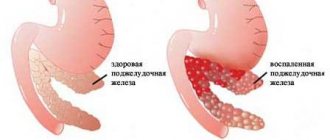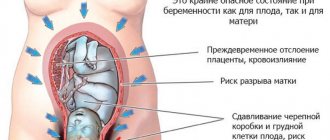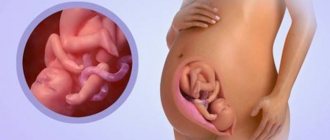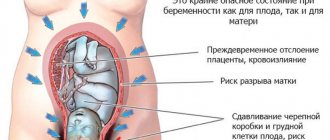Views - 13,317
The last weeks of pregnancy are even more exciting than all the previous ones. But in some cases they are also accompanied by not the most pleasant symptoms, for example, when the stomach turns to stone. Read on to learn why this happens, what the treatment methods are, and much more.
- Side symptoms
- Causes
Diagnostics
Is it dangerous?
If the condition that accompanies the petrification of the abdomen is not painful or forced, and also permanent, then there is no particular cause for concern. At the same time, it is necessary to pay close attention to this in cases where:
- the fetus is hyperactive or passive;
- the stomach becomes hard at certain times of the day;
- strong vaginal discharge (of any color) has occurred.
In such situations, this can really be dangerous and indicate abnormalities in the development of the fetus. And, as a result, provoke premature or “frozen” labor. You should pay attention to other signs that accompany the petrification of the abdomen at 37 weeks. This may indicate why exactly the process presented was started.
Side symptoms
In this case, there can be a lot of additional signs: from improving the general health of the pregnant woman to false contractions. In this regard, they must be divided into positive and negative. The first indicate that labor will begin soon, and the second indicate that the woman in labor has encountered some complications.
Positive symptoms include a temporary improvement in well-being. If at 37 weeks, despite the stiffness in the abdominal area, a woman feels well, this indicates a normal state of health. At this stage, her back may stop hurting, she may experience frequent urination, and panic attacks (which many mothers experience before giving birth).
Negative symptoms are as follows: a sharp increase in the amount of vaginal discharge and a change in their color, changes in temperature (both general and rectal), sharp and short-term painful sensations in the lower abdomen. There are many more similar manifestations and they all indicate that a woman needs to see a specialist.
This is especially true for those expectant mothers who are going to give birth to twins, who have previously had miscarriages or premature births, and for those who have been diagnosed with an ectopic pregnancy. This is a kind of risk group where it is necessary to remember that the reasons why the stomach becomes hard can be very serious.
General information
The 36th obstetric week of pregnancy has begun, which means that the fetus is already ready for life outside the mother’s body. His lungs and nervous system are formed, and his body has accumulated a layer of fat sufficient to retain heat. If the birth occurs now, the baby will be born with a slight weight loss, but nothing will threaten his life. Multiple pregnancies often end during this period, and even in a normal pregnancy, childbirth is just around the corner.
If pregnancy goes on as usual, then the woman feels as good as her already quite large and uncomfortable belly allows. External changes are almost invisible, but the body continues to actively prepare for childbirth.
- In the last month of pregnancy, the expectant mother has the opportunity to literally breathe a sigh of relief. The uterus begins to gradually descend to the bottom, occupying the space between the pelvic bones that have separated by this time. Thanks to this, the baby’s legs do not put so much pressure on the diaphragm, the lungs are leveled and can work almost at full strength, and it is much easier for the woman to find a comfortable position. True, only first-time women experience such relief, since with a second pregnancy, the uterus may drop just before childbirth or even with the onset of labor.
- The prolapsed uterus puts even more pressure on the bladder, and therefore the need to empty it arises more and more often. Perhaps a pregnant woman should reconsider her regimen - drink in small portions and more often than usual. She should be especially careful during the hot season, since quenching thirst with large volumes of liquid can provoke swelling.
- The amount of amniotic fluid may decrease slightly, which is a permissible physiological process. But if the expectant mother suddenly feels that the volume of her abdomen has decreased significantly, she should immediately notify the doctor - this may indicate damage to the amniotic sac.
- Starting from the 36th week of pregnancy, a gradual shortening and softening of the cervix may occur. This suggests that the significant day may come earlier than the expected date, and it is worth double-checking whether everything was purchased for the maternity hospital and the postpartum period.
- At the 36th week of pregnancy, some women are diagnosed with stage II placental aging. For this period, this state of the placenta is absolutely normal, so there is no need to worry, since the baby still receives all the nutrients it needs.
Changes in a woman's body
36–37 weeks of pregnancy is a period when false contractions may occur because the muscles are preparing for childbirth. At the end of the 37th week, a mucus plug sometimes comes out of the cervix, which filled the cervical canal. Throughout pregnancy, it served to protect the child from infections.
Biologically active substances – oxytocin, prostaglandins, and other substances – begin to accumulate in a woman’s body. Thus, the cervix is preparing for dilation and childbirth. Prostaglandins have a relaxing effect on the isthmus, cervix and lower segment of the uterus. They serve as a trigger for the onset of labor.
Oxytocin stimulates α-adrenergic receptors of the uterus and increases the excitability of cell membranes.
The approach of childbirth is judged by a number of signs that occur in the body:
- Lowering of the abdomen . At week 36, the presenting part of the fetus descends to the entrance to the pelvic area. This occurs in primiparous women. In the case of the second and subsequent births, subsidence occurs immediately before birth.
- Hydration of the body . Due to the active absorption of water along with the substances dissolved by it, which then begin to travel throughout the body, the water level in the body increases, which causes swelling and, accordingly, the frequency of the need to visit the toilet increases.
- Vaginal pressure . At the end of the period of bearing a child, discomfort occurs between a weakened pelvic diaphragm and the woman’s increased weight. The pelvic diaphragm supports the pelvic organs, including the vagina, bladder, and uterus. And pregnancy weakens the diaphragm. As the diaphragm weakens, pressure is placed on the vagina, causing pain and a feeling of heaviness in the hips and pelvis. In women who gave birth more than once, there could be damage to the pelvic diaphragm, which led to its weakening, and each subsequent pregnancy weakened it more and more. Thus, vaginal pressure occurs.
- Increased heartburn . The grown fetus overloads the digestive system, preventing it from functioning properly.
- Constipation . It may cause a feeling of fullness or pressure in the vagina. It is during this period that frequent constipation creates the preconditions for the development of hemorrhoids.
- Expansion of the mammary glands and filling them with colostrum . This occurs under the influence of the hormone oxytocin.
The 37th week of pregnancy, like the 36th, will not bring much relief; on the contrary, the woman will experience increasing pressure on the pelvic diaphragm. The child, increasing his weight, uses the pelvic bones as a pillow.
During this period, the waist expands and the breasts enlarge. Colostrum leakage becomes common during this period. Stretch marks may appear around the chest, waist, and hips.
Weight
A pregnant woman at 36 weeks is 11-13 kg heavier than her usual weight, but in some cases the weight gain can be 14-17 kg. This period of pregnancy is especially dangerous for gaining extra pounds - many women, anticipating the upcoming diet associated with breastfeeding, try to eat plenty of delicious food in advance. Gynecologists, on the contrary, advise keeping your appetite in check in the last stages of bearing a child, since every additional calorie is deposited on the sides of not only the mother, but also the baby.
A baby at 36 weeks of gestation weighing more than 4000 g is often the object of admiration and pride for the whole family, but experts know that giving birth to such a baby is very difficult. The process of birth is fraught with complications in the form of weak labor, prolonged labor, hypoxia, and uterine rupture. Therefore, if the last ultrasound shows the baby’s weight exceeding the above limit, the doctor has the right to insist on a caesarean section.
What you need to know about the 36th week of pregnancy
The 36th week of pregnancy brings you closer and closer to the cherished date of birth of your baby. Typically, at such a late stage, many women already know that, by medical standards, pregnancy lasts 40-42 weeks. There are only 4-6 weeks left until the baby is born. This month will fly by very quickly, and after that your life will completely change. You will be responsible not only for your own life, but also for the life of your baby.
How does a child develop?
The fetus at the 36th week of intrauterine development is almost fully developed. All internal organs and systems of the child are fully formed and fully functioning. The subcutaneous tissue and skin have also formed, and the baby already looks completely like a little person. He is ready to be born.
This period of fetal development is characterized by the following features:
- the child continues to improve and grow;
- the weight of the fetus reaches 2500 grams (or a little more), and the height is approximately 43 cm;
- the baby’s movements remain at a level of increased activity;
- the normal functioning of the endocrine, nervous, and immune systems is established;
- the child continues to actively move his arms and legs, and the developed sucking reflex determines the fact that the baby constantly takes his fingers into his mouth and sucks them;
- the child’s body already has the appearance in which the woman will see it for the first time after birth;
- the bones of a child’s skull are still very soft, and this is due to the fact that the baby still has to pass through the birth canal;
- between the cranial bones you can see large areas consisting of cartilage - infantile fontanelles;
- due to the softness of the fontanelles, the bones of the skull are compressed during passage through the birth canal, and as a result, the baby’s head decreases in size;
- when a baby is born, the bones on his head diverge again and take a normal position, and the fontanelles gradually close up;
- the ideal position of the baby's body in late stages of intrauterine development is cephalic presentation, when the head is lowered down;
- there are cases when the child turns to the birth canal not with his head, but with his buttocks, and this position requires delivery by caesarean section;
- It rarely happens that with a breech presentation, a baby is born naturally, without complications or injuries.
Ultrasound
An ultrasound at the 36th week of pregnancy is usually performed unscheduled, because the main studies have already been performed at an earlier stage.
During this period of time, an ultrasound is necessary for the doctor to determine the condition of the placenta, the weight and size of the fetus, and eliminate the risk of the child being entangled in the umbilical cord. All this data is necessary for the specialist to determine whether the birth will be natural, or whether a cesarean section will be required, and whether any complications will arise.
Belly and weight
The size of a woman’s abdomen at this stage is enormous, but it should be noted that they also depend on the individual characteristics of the body.
Some women at 36 weeks of pregnancy have a small and neat tummy. For them, this aspect becomes a cause for concern, which may be justified. The fact is that a small belly for such a long period of time may indicate oligohydramnios or low weight of the fetus.
In any case, if you are worried, contact your gynecologist so that he can dispel your doubts about the baby’s health and the size of his abdomen. It is quite possible that a small belly in the 3rd trimester of pregnancy is simply a feature of a woman’s physique.
Note that at this stage the stomach begins to fall down, along with the fetus, which now rests its head on the pelvic floor. The approach of childbirth invariably entails pain in the lower abdomen. By the way, when it goes down, it becomes much easier for a woman to breathe, and unpleasant symptoms such as heartburn and shortness of breath disappear. The uterus no longer puts so much pressure on the internal organs and therefore urination processes improve, becoming less frequent.
As for your body weight, it may increase significantly by the end of the 3rd trimester. In general, the body weight of the expectant mother during pregnancy consists not so much of the fat layer, but of:
- amount of amniotic fluid;
- the weight of the child himself;
- blood volumes (which increase by approximately 1 l);
- the weight of fat and water that has accumulated in the tissues of a pregnant woman during the entire period of bearing the baby.
The norm is to gain 13 extra kg by the 36th week of pregnancy (compared to the initial weight). In general, during the entire pregnancy a woman should gain weight within 16 kg, but if deviations from this norm are small, then this is not a problem, because the body of each of us is individual.
Discharges - what to pay attention to
In the last weeks before childbirth, there is often an increase in discharge, which becomes viscous and mucous. This is due to the gradual release of the mucus plug, which protected the baby from infection by pathogens. The pinkish color of the mucus indicates an imminent birth.
An infection that has entered the birth canal provokes a change in the consistency of the discharge to a cheesy, bubbly mass. Often such infection is accompanied by unpleasant sensations in the form of itching and burning in the vaginal area.
If bloody discharge appears. Then you should immediately call an ambulance, no matter what their volume. Particularly serious is the situation in which, simultaneously with blood discharge, severe pain in the lower abdomen develops. This symptom indicates placental abruption. Immediate intervention by medical specialists is required.
Liquid discharge that looks like white or yellow water indicates leakage of amniotic fluid. It is likely that labor has already begun, so you should call an ambulance and go to the hospital.
Sexual contacts
Doctors do not prohibit sexual intercourse for women who are in late pregnancy. But it should be understood that orgasm can provoke the appearance of uterine tone and the onset of labor. This happens precisely in the later stages, when the woman’s body is fully prepared for childbirth.
Feel
Sensations The range of sensations during this period remains varied. Pay attention to painful sensations, which can be of a different nature.
1. Heavy loads on the lower back and back, which are invariably accompanied by pain, arise due to strong stretching of the uterus, its pressure on the internal organs, and a strong shift in the center of gravity.
2. The last weeks of pregnancy are accompanied by pain in the pubic area and hip joints, which arise as a result of their softening and relaxation.
3. Hemorrhoids (cracks in the anal passage) cause severe pain in a pregnant woman.
4. Increased tone of the uterus will be indicated by nagging pain in the lumbar region, a feeling of fossilization in the abdomen, and severe nagging pain in its lower part. This situation is dangerous and threatens premature birth, so you should definitely consult a doctor.
5. Many women experience severe swelling of the lower extremities at the final stage of pregnancy. They can appear even in women who were not aware of this problem in the early stages. This situation occurs most often due to the fact that the uterus strongly compresses the veins in the pelvic area, which causes a deterioration in the outflow of blood from the lower part of the expectant mother’s body.
6. One should also take into account the fact that edema can be of a different nature and be a symptom of developing gestosis. This is a very dangerous complication of pregnancy, which is associated with disruption of the normal functioning of the kidneys and urinary system. Swelling during gestosis is accompanied by increased pressure and the presence of protein in the urine.
7. The norm is the appearance of swelling in the legs at the end of the day, after a woman has been sitting or standing for a long time in one position.
In addition to pain, you will experience other sensations during the 36th week of pregnancy.
- The baby's tremors inside the womb, which are especially noticeable in the last weeks of pregnancy due to the fact that the baby is already cramped in the mother's stomach.
- It is considered normal if the baby makes about 12 movements in 10 hours.
- Before childbirth, anxiety increases, especially if a woman is about to give birth for the first time. excessive nervousness, capriciousness and irritability are typical companions of anxious states in pregnant women.
- It becomes more and more difficult to walk, the stomach is very heavy and pulls down, hindering all movements.
Premature birth
Premature birth. Childbirth at 36 weeks of pregnancy is not that uncommon. They are no longer considered premature and not pathological.
The duration of a normal pregnancy is about 40 weeks (± 2 weeks). That is, childbirth can occur as early as the 38th week of pregnancy, and if you consider that doctors may make mistakes in calculations, then the birth of a baby at the 36th week is not something surprising.
Dangers
Among the main dangers of the 36th week of pregnancy are:
1. Late toxicosis;
2. Pain in the lumbar region, back, abdomen, hypochondrium;
3. Varicose veins;
4. Clumsiness and clumsiness (due to a large belly);
5. Decreased blood circulation and reduced oxygen flow to the fetus due to edema;
6. Fluctuations in hormonal levels can trigger hair growth on the face and body (in unwanted places).
Belly at 36 weeks pregnant
The thirty-sixth week of pregnancy is characterized by the fact that the growth of the expectant mother’s abdomen becomes less intense, because the child is no longer growing at such a rapid pace as before. The height of the uterine fundus in relation to the pubic symphysis is 32-37 cm, the approximate abdominal girth is 90-98 cm.
At this time, wearing a bandage becomes mandatory for multiple pregnancies , as well as for women with an already drooping belly, excess weight, and the threat of premature birth. Many expectant mothers do not like to wear a bandage, complaining that it puts pressure on the stomach and hinders movement. To avoid this, you should select an elastic belt in accordance with the size and mandatory preliminary fitting.
Sometimes you can hear complaints from pregnant women about what they consider to be a too small tummy. However, if the child is developing normally, there is a sufficient amount of amniotic fluid and the condition of the placenta is appropriate for the period, there is no reason to worry.
A small belly throughout pregnancy is often observed in women with a fragile constitution, when carrying a small baby, and also if the placenta is located on the back wall of the uterus.
Many women note that their stomach becomes rocky at 36 weeks of pregnancy. You shouldn’t be afraid of this, because this most likely indicates training contractions. If this symptom causes a woman great discomfort and is accompanied by severe pain, then she should consult a doctor.
Recommendations
To ensure that the last weeks of pregnancy pass easily and without much discomfort, you should follow some rules.
Nutrition
During this period, the body should receive a large amount of healthy carbohydrates. Nutrition at 37 weeks of pregnancy is not aimed at the development of the fetus, but at preparing the mother for childbirth. The diet should include wholemeal bread, vegetables, and cheeses.
Do not forget about the volume of water you drink - about 2 liters per day, unless your doctor recommends a different regimen.
Vitamins
And even now doctors remind us about vitamins. A woman carries a baby, feeds two, so no one has denied her calcium, iron and other elements that can be obtained from vegetables and fruits. Don't forget about meat and dairy products.
Sex
Sexual activity should stop completely if the pregnant woman notices that she has a mucus plug. Well, if everything is fine with mommy, and the doctor did not impose a ban on sex at 37 weeks of pregnancy, then you should not deprive yourself of pleasure. Moreover, sperm will help the cervix become more elastic.
Physical activity
With such a belly, not everyone can flutter like a butterfly, so usually all physical exercises come down to breathing exercises. After all, proper breathing is so important during childbirth.
It's a good idea to learn a few exercises to relax muscle groups. If her health allows, a woman should not stop walking in the fresh air.
Medicines and medical procedures
It is not recommended to use medications without first consulting a doctor.
Woman's feelings
The main attention, as before, is focused on the baby’s movements. Since by the end of pregnancy they become less active due to the fact that the grown child has nowhere to turn around, gynecologists advise expectant mothers to count the number of movements - in 12 hours there should be about 10. If the fetus loses activity, you should play it safe and consult a doctor - perhaps , some problem has arisen. But you shouldn’t get hung up on the movements - many women, fearing a frozen pregnancy, literally do not allow the baby to rest, pushing him away every time he falls asleep. If anxiety has reached its climax, you should think about purchasing a home fetal doppler - a device that allows you to listen to the fetal heartbeat at any time.
From about the thirty-sixth week of pregnancy (for some earlier, for others later), a new sensation may arise - fear of the upcoming birth. This feeling can appear in any woman, regardless of the number of children she carries under her heart. You should not keep anxiety to yourself - it will depress the nervous system, disrupt sleep, and provoke bad dreams and thoughts. To put yourself in a positive mood, you can enroll in childbirth preparation courses: knowing how the process of giving birth to a child occurs will give the expectant mother more self-confidence. The consent of the child's father to a partner birth will also have a positive effect on her nervous system.
Women may be concerned about symptoms predicting labor. Precursors of labor in first-time mothers will include the following symptoms:
- Abdominal prolapse;
- The discharge of the mucous plug occurs both 1 day and a week before birth;
- Abnormal stool;
- Decreased motor activity of the baby;
- Training contractions.
The harbingers of labor in multiparous women are not much different from those in primiparous women. Moreover, during the second birth, these symptoms may occur more vividly and rapidly.
Feelings of fullness in the abdomen in early pregnancy
In early pregnancy, stone belly can occur for obstetric and non-obstetric reasons. Most often, pain is the norm, because the body begins to rebuild and hormonal disruption occurs. Let's list the most common reasons:
- stone belly syndrome. Appears due to a lack of the hormone progesterone, which is vital for a woman during pregnancy. Additionally, unnatural tightness of the abdomen appears. This syndrome occurs in multiparous women, if little time has passed between births;
- hormonal imbalances. Hormones begin to be produced unevenly in the body and the woman feels the hardness of her abdomen for a short time. This reason occurs in primiparous women;
- weak pregnancy. You can recognize it by its brown discharge. A woman should consult a doctor, as this indicates underdevelopment of the fetus;
- ectopic pregnancy. The egg is located outside the uterus and is accompanied by pain in the sacrum;
- risk of miscarriage. There is little progesterone in the body, which is why the uterus begins to contract and the embryo is “pushed” out.
Listen to yourself
The first two reasons are the norm. A gynecologist will help you get rid of them. You need to adjust your diet and the doctor will prescribe herbal-based medications.
In other cases, it is also necessary to consult a doctor. If your lower abdomen feels tight in the early stages, you haven’t been able to get pregnant for a long time, and you have a hardened abdominal region, contact your gynecologist and get tested for hormones.
Fetus at 36 weeks
The following processes also occur in the baby’s body:
- He already recognizes not only his mother’s voice, but also some of the most frequently repeated external sounds. If they are too loud, he may flinch and show displeasure by pushing his legs;
- The child's skeletal system continues to strengthen. Despite the fact that the period of her main development is already behind her, the expectant mother still needs a lot of calcium. The bones of the skull are movable - this is necessary so that the head can freely pass through the birth canal;
- His facial features are fully formed - this is exactly how his mother will see him after birth;
- Meconium or original feces has accumulated in the baby’s intestines - waste products of his eight-month intrauterine life. Normally, it should come out naturally within a few days after birth, but sometimes this happens while it is in the tummy;
- At 36 weeks of pregnancy, all the necessary reflexes are formed - swallowing, sucking, grasping. He swallows amniotic fluid, sucks fingers, feels his face, body, umbilical cord, and wraps his legs.
In addition, around the 36th week, the baby gradually begins to lose the mucous lubrication of the skin, which protected it from constant exposure to amniotic fluid. By the day of birth, there will be just enough lubricant left to pass through the birth canal.
The weight of a child at 36 weeks of pregnancy is approximately 2750-2900 g, height - 45-47 cm. If at this stage he has not yet assumed a cephalic presentation, the gynecologist can recommend special exercises that will encourage him to roll over. This is standing in a knee-elbow position, performing special turns, bends, etc.
Feel
During this period, especially at week 37, contractions of the Braxton-Hicks type are increasingly repeated. Sometimes the amount of vaginal discharge increases, and small patches of bloody mucus indicate impending labor. During this period, the expectant mother may have strange and vivid dreams while sleeping, because the approaching birth feeds the unconscious imagination.
Preparatory attacks may begin, this occurs at 37 weeks. Although this is an early stage, attacks may nevertheless be frequent and regular. During false attacks, pain occurs only in the lower abdomen. It can occur when changing physical activity or changing position.
The pain that indicates the onset of labor begins not only in the lower abdomen, but also in the lower back.
Moving gradually downwards, the fetus puts pressure on the pelvis, but at this moment it becomes easier for the woman to breathe, she can take a deeper breath.
Ultrasound
Basically, in the 36th obstetric week of pregnancy, an ultrasound is not performed, because the third screening has already passed. But according to indications, the doctor may prescribe an examination during this period.
Ultrasound is necessary for:
- Clarification of the position of the fetus in the uterus;
- Exceptions to its entanglement with the umbilical cord;
- Assessment of the condition and degree of maturity of the placenta;
- Development assessments;
- To clarify the child’s weight and height;
- Position of the fetus. It should be positioned head down.
Based on the data obtained, the doctor will be able to decide on the method of delivery.
Tests and medical examinations
36–37 weeks of pregnancy is the period when it is necessary to undergo an examination by an obstetrician-gynecologist.
What is included in the examination procedure:
- blood pressure measurement;
- weighing;
- measuring abdominal circumference.
- determining the height of the uterus;
- determination of the position and presentation of the fetus;
- listening to the baby's heartbeat.
In addition to measuring procedures, the expectant mother must undergo a urine test. He gives himself up before each visit to the gynecologist, which helps him identify abnormalities that have occurred in the mother’s body.
What may appear in urine and why it is dangerous:
- Acetone . It occurs due to vomiting during toxicosis and signals problems in the liver.
- Sugar . If the normal level is exceeded, a test to detect diabetes is prescribed.
- Protein . Increased pressure in combination with the appearance of protein indicates the beginning of the process of nephropathy (preeclampsia).
An altered urine rate helps to timely identify the onset of kidney disease. During this period, it is advisable to undergo screening for group B streptococci. This bacterium is usually found in healthy people, maybe in the mother, and during childbirth it can be transmitted to the child and subsequently cause an infection in the lungs.
During this period, an ultrasound is prescribed to monitor the fetal heart rate, determine the correct presentation of the baby and the position of the placenta. Normally, the placenta should be about 35 cm thick and have a second degree of maturity.
An important ultrasound indicator at 36 weeks is the amount of amniotic fluid or amniotic fluid. Both oligohydramnios and polyhydramnios are dangerous for the child, since the presence of these signs indicates premature birth.
Discharge from the genital tract
Maintaining the health of the genital organs is one of the primary tasks of the expectant mother. She must carefully maintain their hygiene and try not to wear synthetic underwear. At this time, it is better to avoid swimming in open waters - it is easy to catch some kind of infection in them, for which there is very little time left for treatment.
If the discharge has become more mucous, this most likely indicates a gradual release of the mucus plug . Amniotic fluid may break at any moment - evidence of labor beginning; often during this process, the lower abdomen feels tight. Regardless of whether contractions began after this or not, it is necessary to quickly go to the maternity hospital, under the supervision of specialists. A child’s long-term (more than 12 hours) stay in a waterless space is very dangerous - he stops receiving nutrients and oxygen.
The amount of amniotic fluid matters - if there is little water (250-300 ml), then this is the so-called anterior water. If they leave, you can calmly take a shower, get ready for the maternity hospital, call the doctor and the future dad. The amount of water remaining in the uterus is enough to provide the baby with everything he needs for 15-20 hours. If the volume of liquid is approximately 900-1200 ml, this indicates that the water has almost completely receded. In this case, you cannot hesitate.
How to determine the amount of waste water? It’s very simple – experimentally. The expectant mother can fill a container with 300 ml of water and, standing in the bathroom, pour it on her feet. Then do the same with 1 liter and make sure that the difference is very noticeable.
Childbirth
There is a high probability of giving birth at 37 weeks of pregnancy in multiparous women, as well as pregnant women who are carrying twins or triplets. This is the norm for such categories of patients. This is why you need to prepare for childbirth in advance.
You should listen to your body. Childbirth can be recognized at 37 weeks of pregnancy by the following signs:
- discharge of the mucus plug;
- contractions that occur more frequently than every 5 minutes;
- rupture of amniotic fluid.
With such manifestations, you should go to the maternity hospital without hesitation.
Possible problems
Childbirth at 36 weeks of pregnancy is no longer as scary as it used to be. After all, the baby is already viable, and his body is almost ready for independent existence.
During this period, one of the most dangerous complications is still late toxicosis, which can lead to swelling, increased blood pressure, weight loss, and fetal hypoxia. The ailment can be treated with medication, but in some cases doctors still have to induce premature birth to prevent the death of the child.
To prevent the 36th week of pregnancy from being overshadowed by the occurrence of this disease, the expectant mother is advised to:
- spend as much time as possible outdoors;
- Healthy food;
- Under no circumstances should you drink alcoholic beverages, even in small quantities, and even if you really want to (some people allow themselves to do this, thinking that nothing can harm a mature child).
As over the past few weeks, a pregnant woman needs to take care of her own balance - due to a shift in the center of gravity, it is very easy to lose it, and then a heavy, large belly will make a fall inevitable.
Another problem is abnormal bowel movements, which may indicate that labor is approaching. Diarrhea at week 36 may be accompanied by nausea or vomiting. That is why pregnant women often confuse such a harbinger of childbirth with poisoning.
Fetal development
After 36 weeks, the baby slows down the rapid growth phase and begins to descend into the birth canal. It should be positioned upside down towards the cervix and vagina. Its extra weight, combined with its high water content and full blood vessels, helps the body prepare for labor by softening the cervix.
At 36 weeks, he is still accumulating subcutaneous fat, which makes up 15% of his total weight. The fat layer will round out the face, smooth out wrinkled skin, help maintain body temperature and provide energy. During this period, the baby has completed the development of sucking muscles, and they are ready for the first feeding. Every week, until birth, the baby will gain 200 g.
The length of the fetus during this period averages 46–48 cm, weight is about 2.5–3 kg, chest diameter is 94–97 cm. 36–37 weeks of pregnancy is the period when the fetus is almost fully formed, but At week 36, his nervous and immune systems are still developing. And 37 weeks is quite suitable for childbirth. The baby has finally taken shape and completed its development.
36-37 weeks of pregnancy, fetal development.
At week 37, the child gets the idea of inhalation and exhalation, hair has completely grown on the head, if it was genetically laid down. Often a child is born bald. As the baby grows, the amount of amniotic fluid around him decreases. During this period, the baby’s liver and kidneys are fully functioning, blood circulation occurs, the skin becomes soft and smooth, and the gums become hard.
Sex at 36 weeks
Regarding the admissibility of sexual contacts after the 36th week of pregnancy, the opinions of different gynecologists may differ. This is not surprising - every pregnancy is individual, so the advice is also different.
Some women should refrain from intimacy, since their uterus has already descended into the pelvic area, the cervix has begun to contract and soften, and they often feel training contractions. All of the above signs indicate that the body is actively preparing for an imminent birth, and any external influence can provoke the premature birth of the baby.
The body of other women at 36 obstetric weeks does not show any signs of readiness for an exciting event - doctors note the high position of the uterine fundus, its cervix is still tightly closed and elongated. Therefore, the decision to continue sexual activity should be made by a couple after consultation with a doctor.
Tests and ultrasound at 37 weeks of pregnancy
At the end of your pregnancy, you will need to have a urine and blood test. In addition to this, the pregnant woman is given directions for some repeat tests.
Most likely, you no longer need to undergo an ultrasound, but in some cases this has to be done.
An ultrasound at 37 weeks of pregnancy will show that the baby’s body parameters are:
- BPR: 94 mm;
- exhaust gas: 339 mm;
- Coolant: 311 mm;
- PJ: 100 mm;
- SJ: 98 mm;
- hip: 71 mm;
- shin: 60/62 mm;
- shoulder: 63 mm;
- forearm bones = 51/58 mm.
But each baby is an individual organism, and its parameters may differ from the standards.
Nutrition at 36 weeks of pregnancy
In the later stages of pregnancy, the expectant mother, as before, needs to pay a lot of attention to her diet. It must contain the required amount of foods rich in calcium, magnesium, and iodine.
It is better to exclude allergenic foods from the menu in advance:
- peanut;
- citruses;
- chocolate;
- smoked meats;
- exotic vegetables and fruits;
- red fish.
You should also not overuse summer berries - strawberries, raspberries, gooseberries. They are certainly very useful, but it is better to eat a total of no more than 0.5 kg per day.
Main reasons
Now it’s time to take a closer look at the reasons why a stone belly appears.
If a pregnant woman’s stomach hardens at 37 weeks, these may be harbingers of labor. Additionally, swelling of the legs of the expectant mother is added. The stomach becomes stone during pregnancy at 37 weeks because the baby has practically grown, there is less and less space for him.
Childbirth coming soon
If you have 3 weeks left before the PDR and suddenly your stomach begins to feel hard, be sure to go to an appointment with your family doctor or make a house call. It’s worth preparing your things and getting ready to leave for the maternity hospital.
The baby no longer has enough space and begins to “ask” to go outside. Don't worry - this is not a sign of pathology, it is a sign that you are about to give birth. It is periodically difficult for a pregnant woman to walk in the thirty-ninth week of pregnancy.
When the stomach becomes hard, there is a desire to quickly relieve the tightness, especially at 39 weeks of pregnancy. But there's no need to panic. There is no need to be afraid of the harbingers of contractions, because the 39th week of pregnancy is always accompanied by a stone belly.
Night or day, a feeling of hardness in the abdomen appears at 40 weeks before giving birth. The location of pain in the spine and back is beginning to bother me more and more often. The nagging pain cannot be avoided. It's important to talk to your doctor to help you prepare for labor on time. The pregnant woman should have a mucous plug and amniotic fluid that is practically colorless.
Hypertonicity
Not always normal. The uterus is an organ that consists of smooth muscles. It contracts so that the woman can give birth to a child. In a normal state, a woman does not feel any changes, pain or discomfort.
Feminine look
If a pregnant woman’s stomach regularly becomes stiff, it means the uterus contracts too often. This phenomenon is dangerous at the beginning of the term. Additionally, the woman feels that her lower back hurts and her lower abdomen constantly ache.
In late pregnancy, the symptom is long-lasting and occurs 4-5 times per hour. The attack can last 20 minutes, but sometimes it occurs every 10 minutes. It is better to get examined and inform the gynecologist about the problem in order to exclude possible pathologies of the fetus and the expectant mother. At the same time, the upper abdomen never hurts.
If you are at 37 weeks, then the final stage of pregnancy is periodically accompanied by a hardening of the abdomen - think about what could trigger the phenomenon. If you don’t find any factors, pack your bag for the maternity hospital.
Exercise before childbirth
At any stage of pregnancy, doctors advise to walk more, move and breathe fresh air. This is necessary so that the child develops correctly and the birth is as easy as possible. But not a single doctor will advise a woman to do exhausting exercises in the gym. Such loads in the third trimester provoke uterine hypertonicity.
Any physical exercise is a slight stress for the body, and for a pregnant woman it is dangerous. Labor may begin prematurely or the fetus may be at risk. If during the exercise you feel that the child is moving, immediately stop the load. If the pain goes away quickly, there is no reason to worry.
The main thing is not to overdo it.
When the abdominal area becomes stiff at 38 weeks, and at the same time it pulls down, you need to reduce any physical activity during pregnancy. At 39 weeks the same recommendations.








